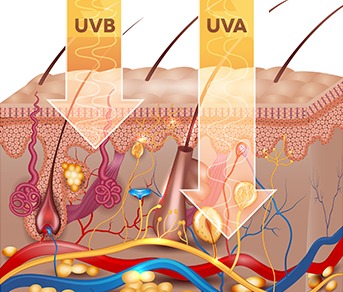Sun Damaged Skin Treatments and Prevention
Although sun exposure is important to help maintain vitamin D levels, too much sun can put the body at high risk of cellular skin damage. Long-term exposure to the sun without appropriate protection is possibly the largest contributor to the visible signs of ageing. Protecting your skin from the sun’s harmful rays can reduce the chance of sunburn, brown spots (sun spots) and faster skin ageing, whilst helping to protect against skin cancer.
Harmful Effects of Sun Exposure

Harmful Effects of Sun Exposure
Apart from helping the body produce Vitamin D, sun rays also contain ultraviolet rays, which can be damaging to skin health.
The outer layer of skin, called the epidermal layer, contains the melanin pigment, which is designed to protect the skin from these ultraviolet rays. However frequent exposure to sunlight causes the skin to produce more melanin leading to the skin darkening, resulting in a suntan. While most individuals find sun tans desirable, this is actually the skin’s defence mechanism to the sun.
Sunburns occur when the skin has had too much exposure to the sun and its ultraviolet rays. These UV rays penetrate past the epidermal layers and into the deeper layers of skin tissue where it then damages and/or destroys vital skin cells. This can then lead to skin cancer. Those with paler complexions are typically more likely to suffer from sunburn than those with darker complexions due to having less of the melanin pigment.
Signs and Symptoms of Sun Damaged Skin
There are 5 common symptoms of sun damage:
Dry Skin - Skin that has had too much sun exposure can start to lose moisture and essential oils making the skin appear dry and cracked. Dry skin can also lead to wrinkles and lines no matter the age of the individual.
Sun Spots - Also known as solar lentigines, sun sports are brown flat spots that show up on parts of the skin that have been exposed to too much sun. Any UV rays from the sun will then keep darkening the sunspots and make them appear more noticeable. Freckles are similar to sunspots however freckles occur primarily on the face and in children with fairer complexions.
Sunburn - This is the condition of the skin after it has been exposed to harmful UV rays from the sun. It is characterised by redness, warm yet painful to the touch and in severe cases can blister. Individuals who have less of the melanin pigment are more likely to suffer from sunburns.
Actinic Keratosis - These develop in areas of the skin that have undergone repeated long-term exposure to the sun and its UV rays, and are a common warning sign of skin cancer. The appearance of actinic keratosis is a tiny bump that is rough to the touch and can be red, pink, brown or yellow in colour. Unlike tans and burns, actinic keratosis does not go away without medical intervention.
Premature Ageing - UV radiation from the sun can cause collagen to break down at an increased rate by penetrating the dermis layer (middle layer) of the skin and causing an abnormal build- up of elastin to which enzymes are then produced that break down the collagen leading to wrinkles and premature ageing.
Treatment for Sun Damage

Treatment for Sun Damage
Although there are many treatments to help improve sun damaged skin, prevention is better than a cure.
The following treatments are most common to help treat skin that has already been damaged by the sun’s harmful rays:
Moisturisers and Creams – Sun exposed skin is more likely to suffer from dryness, which can lead to wrinkles and other premature ageing symptoms. So it is important to regularly moisturise everyday whether it’s a sunny day or not as the UV rays are still present. You can buy moisturisers with SPF in them to help prevent more sun damage, as well as creams that can help fade hyperpigmentation brought on by sun exposure (e.g. sunspots and freckles). Obagi provide a range of products to help prevent and protect skin from sun damage.
Chemical Peels – Skin/Chemical Peels can be used to help reduce the appearance of sun damage on the face by using a chemical solution that removes the old epidermis layer of skin (which is visibly damaged by the sun), leaving in place a new epidermis layer of skin that appears smoother, less wrinkled and lighter in colour. This is most effective on fair-skinned individuals who have sun-damaged skin.
Surgery – There are a range of surgical options for sun-damaged skin, such as Laser Resurfacing and Light Therapy. Laser resurfacing works similar to a chemical peel by removing the epidermis layer of the skin, but instead of using chemicals it uses a laser to remove it. Light Therapy is a non-toxic and non-invasive treatment that repairs the sun damaged skin by using light energy. This also encourages skin cell regeneration.
Preventing Sun Damage
There are many products and methods that are effective in preventing symptoms of sun damage. Here are the most common preventative treatments for sun damage:
Sunscreens – everyone should be wearing sunscreen. Whether you’re in a hot or cold climate, the sun’s harmful rays don’t depend on the temperature or weather. There are many different sunscreen products on the market, however some are more effective than others. Obagi Medical Products offer a range of different Sun protectors that range in SPF strength, including Obagi Sunshield Matte SPF50 and Obagi Physical UV Block SPF32. Obagi sun protectors have been specially formulated to prevent sunburn and guard against the damaging rays of the sun to prevent premature ageing.
No Lunch Time Exposure – The sun’s UV rays are at its strongest between 10am and 4pm. This is the time where it is most likely that sun damage to skin occurs. It is best to stay inside during these peak hours or at least stay under a cover, like an umbrella, to prevent the harmful rays from reaching your skin.
Cover Up – Wearing longer sleeves or dresses and trousers compared to just a bathing suit is more sensible when it comes to sun exposure. The less skin you expose the less likely it is you’ll experience sun damage on your skin. There are special clothing ranges that have a high UPF rating. This means sun rays cannot penetrate the clothing as easily and damage the skin underneath. Wearing hats outside in the sun also contributes to protection as it protects the face, ears and neck from the harmful rays. However, sunscreen should also be used alongside clothing.
How Can We Help?
Healthxchange is a trusted supplier of pharmacy products to healthcare professionals and offer a range of treatments that can be used to help prevent and manage sun damaged skin.
Obagi Sunscreens are formulated to prevent sunburn and protect the skin. Guarding against the damaging rays of the sun helps to prevent the visible signs of ageing, such as fine lines, wrinkles, dry skin, sunspots, sallowness and poor skin tone.
Obagi Medical Products have recently added to the range of sun protection with the addition of the New Obagi Sun Shield SPF50 Tint. Available in both warm and cool tints to match a range of skin tones, this new Sunshield offers both a physical and chemical protection for the skin.
To find a clinic near you offering Obagi Suncreens, use our free Clinic Finder.

